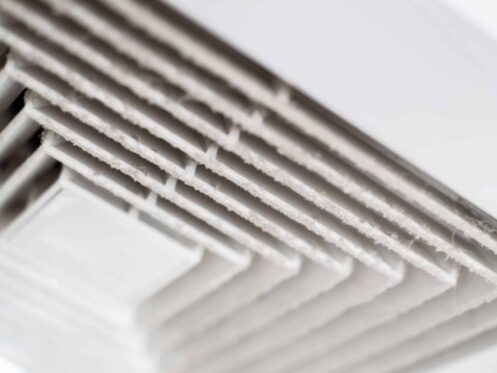Springtime is associated with new arrivals and new beginnings. However, some of these beginnings are more celebrated than others. Cherry blossoms are welcome, but pollen allergies are a different story!
The truth is that spring can be rough in terms of indoor air quality. You might have to battle everything from outdoor allergens to indoor chemicals spread by your spring cleaning products. Fortunately, there are steps you can take to improve your air quality, reduce the impact of pollutants, and breathe easier in your home.
What Is Indoor Air Quality?
While it might sound self-explanatory, indoor air quality (IAQ) is a complex subject that’s continually being explored, tested, and refined by everyone from the EPA to NASA.
The simplest explanation is that air can be contaminated. These contaminants can include gases such as carbon monoxide, allergens like pollen and ragweed, and chemical pollutants such as formaldehyde. Some of these harmful agents are identified as volatile organic compounds (VOCs), and VOC level is often what gets measured in air quality tests.
To evaluate your own indoor air quality, it’s recommended that you call a professional. High-quality equipment will provide better readings than at-home testing kits. If issues are discovered, you can speak with your technician about plans for improvement.
Signs and Symptoms of Poor Air Quality
Sneezing might be an annual tradition for you in the springtime, but be careful not to let your allergies disguise the symptoms of poor air quality. You’ll suffer needlessly when there are solutions at hand. You might also do damage to your HVAC system if you let small problems snowball into bigger ones because you weren’t paying attention to things like clogged air conditioner filters. Not only does this compromise your air quality, but it can increase your utility bills, too!
Here are just a few things to watch out for if you suspect problems with your indoor air quality:
- Coughing, sneezing, and sniffling
- Headaches
- Nausea
- Sinus problems
- Skin dryness or irritation
- Sleeping problems
- Fatigue
Another sign of bad air quality is when your symptoms get worse when you’re at home. If you breathe just fine at work but start sniffling as soon as you walk through your front door, that’s a strong indication that you need some air quality management. An additional sign is when your symptoms start before spring or continue after spring. Those can’t be blamed on pollen alone.
How Air Quality Changes in the Spring
Every season can impact your home’s air quality, but spring and fall tend to be the worst offenders since they bring pollen and ragweed allergies, respectively.
It starts with a process known as “infiltration.” This is when pollutants enter your home. You might bring them in yourself on your clothes, or they might seep in through the cracks of your doors, walls, and windows.
The next part of the process is ventilation. “Natural” ventilation is basically the air that gets circulated by movement, including the opening of doors and the passage of people through various rooms. “Manual” ventilation is the kind employed by HVAC systems and their vents and ducts. Depending on the kind of spring weather that you’re having, you might be using either your furnace or your air conditioner for air circulation, and both of these appliances have filters that can impact air quality.
A final term to know when discussing indoor air quality is “air exchange rate.” This is the amount of outdoor air that’s replacing indoor air. In the spring, a high air exchange rate can mean lots of allergens entering your house and staying there.
Things That Can Impact Your Indoor Air Quality
There are many factors that can both help and harm your indoor air quality level. These include:
- Your home’s HVAC system
- Your exposure level to pollutants
- Chemicals from household products
- Allergens dragged in from outside
- Fuel-burning appliances
- Mold and mildew
- The presence of air purifying agents
HVAC Improvements for Springtime
Your HVAC system can be one of the biggest defenders of your home’s air quality. You might need to make some repairs or call in some professionals to install newer parts, but the effort will be worth it when you’re able to breathe in cool, clean air.
The first thing to consider is your filters. It doesn’t matter whether you’re running the heater or the air conditioner; both have filters that need to be changed regularly to prevent the buildup of dirt, dust, and other debris.
Another consideration is your ductwork. This refers to the ducts throughout your house that is responsible for carrying and venting air. Just like filters, they can become dirty over time, so a duct cleaning will remove all of their harmful microorganisms from the oxygen being sent around your home.
Last but not least, consider scheduling a maintenance visit for your HVAC system. A technician might find something like low refrigerant levels or blower fans needing more lubrication, both of which can affect the efficiency of your air conditioner. There’s also the fact that even a clean, well-maintained system can become worn out over the years, so certain components might need a tune-up or an entire replacement.
Other Ideas to Improve Home Air Quality
There are a number of tools that can help you with the air quality of your home.
The most obvious are air purifiers that can filter out particles like dust, smoke, pollen, and pet dander from your breathing air. While most commonly available as portable, self-contained units, you can also purchase air purifying features for ceiling fans and other HVAC systems or components. These can often be incorporated into your existing HVAC system without the need for extensive overhauls. On the other hand, if you’d like an extensive air purification system, you can arrange for the installation of a whole-home air purifier.
If you like flowers, they can help with air quality levels, too. Certain species like dracaenas, chrysanthemums, and spider plants have been proven to strip VOCs from the surrounding atmosphere. Different species can be used to tackle different VOCs, including ammonia, carbon monoxide, formaldehyde, and more.
Lastly, try reducing the number of contaminants that you’re bringing home in the first place. A good offense can be the best defense! Leave your shoes and jackets in the mudroom if they’ve covered in pollen. Invest in organic, chemical-free cleaning products that won’t add to the VOC levels in your house. Take care of the cracks and crevices in your home structure that are heightening your air exchange rate.
How to Breathe Better in the Spring
Springtime is a beautiful time, but it can have its challenges as well, especially in terms of indoor air quality. If you miss the days when you could take a deep lungful of air without coughing, reach out to Environmental Heating & Air Solutions in Roseville. We offer installation, maintenance, and repair services for both heating and cooling units. We’re equipped to handle everything from insulation to ventilation issues that could be impacting your air quality.

